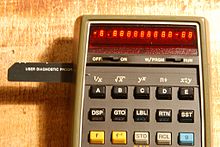I’ve recently released two Windows-based calculator emulators: the hp29w and the hp67w:
![]()
![]()
They’re both pretty easy to use and fairly intuitive, but I do want to cover off some of the finer points.
Data Entry and Functions
This is one of the easier topics: you just click the relevant button(s). So far, there’s nothing fancier than that (like keyboard shortcuts eg pressing ‘5’ to click the ‘5’ button). It’s likely to come at some point, but it isn’t there yet.
If you don’t already know these calculators, you can find out what the buttons do from the relevant Owner’s Handbook. Both of those are available (via the HP-29 topic page or the HP-67 topic page).
Switches
Both calculators have two switches below the display. The left hand one is the OFF-ON switch and the right hand one is the [W/]PRGM-RUN switch. If you click anywhere on the actual switch, it will change to the other side.
Clicking the ON switch, turns it OFF. The calculator will normally also close down. (If you are debugging – see a later article (the-new-calculator-debuggers) – it will go back to the debugging prompt instead).
Clicking the RUN switch, swaps to PRoGraMming mode and lets you enter or modify a program. (If you are debugging, the calculator has to be running or tracing for the display to change).
Clicking the [W/]PRGM switch swaps back to RUN mode (with the same note again about debugging).
For now at least, you have to click the switch itself; not the text at either side.
HP-67 Magnetic Cards
The real thing came with magnetic cards that you could save programs and data on, and later reload back into the calculator. It was amazing at the time. You could load side 1 or side 2 of a short magnetized card. If it was a long program or there was lots of data then the calculator would display “Crd” to prompt you to load the other side too.
For the Windows emulator, you can click the left hand side of the card slot to load side one; or the right hand side for side 2. The card slot is just above the A to E keys and just below the two switches. On the real thing, the card would go into a slot on the left hand side of the calculator. You can see it best in the following:

(by Pirere, CC-BY-SA, see wikipedia for details)
The picture is a HP-65, the HP-67’s predecessor, but the card slot is the same.
When the card had been read it would come out of a matching hole on the right hand side and be placed above the A-E keys to show what those programmable keys now do.
For the emulator, the card content is read from crd/side1.dat and/or crd/side2.dat, and then crd/card-01.bmp is displayed above the keys.
This makes it easy to create a set of cards in a set of directories, each with a side1, side2 and picture. You can simply copy the contents of any of those directories into the crd directory to choose a card. You can also write or draw any labels you need on the bitmap picture by using MSPaint or similar.
Writing cards works the same way. If you want to keep a card for later, and not just write over it, you should copy the contents of the “crd” directory to somewhere safe. Note that, if you unZIP hp67w into “…\Program Files…\…”, Windows will prevent you from saving cards (writing in that area). I recommend unZIPping to somewhere that does support writing.
If the real thing encountered an error when writing (or reading) the display would show “Error”. The emulator matches this behaviour and you can see this by reading a “crd\sideX.dat” file that has been deleted or trying to write to a write-protected card. You used to write protect cards by clipping off a corner. For the emulator, you can right click the emulator “crd\sideX.dat” file, choose properties, and tick the Read-only attribute. (You “un-clip the corner” by unticking the same property.)
HP-29 Continuous Memory
The HP-29C didn’t have a card reader but it did have continuous memory. That meant you could turn the calculator off and resume from where you left off later on. It retained programs, data storage registers and, at least, the X register value.
The emulator works almost exactly the same. Where it differs is that it retains a little more than the real thing. I saw that as not affecting anything or, at most, a slight benefit.
The way the emulator deals with Continuous Memory is to save and restore program and data automatically on power on and power off. The way it works is very similar to how the HP-67 card reader works. It’s like loading a card when you power on, and saving it again just before you power off.
This means you can use the same tricks I just mentioned for loading and saving a deck of cards, with the hp29w. The differences are:
– information is saved in a “mem” directory (instead of “crd”)
– all of the information is saved to / loaded from “ram.dat” (instead of “side1.dat” and “side2.dat”)
– there isn’t a “card-01.bmp” file.
I really liked Continuous Memory with the HP-29C. The only downside was, sometimes, you did need to enter a different program. With the emulator however, by copying the contents of “mem” in and out, you can enter an entire program (or data) in less than a second. I like that a lot.








